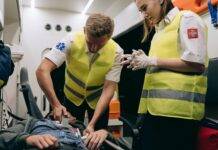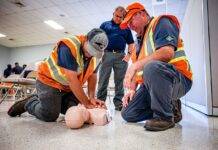
Emergency First Aid at Work
Introduction to Emergency First Aid
Emergencies can occur anywhere, anytime. Understanding how to respond swiftly and effectively to workplace incidents is crucial for preserving life and preventing further harm.
Legal Requirements and Responsibilities
Employers bear the responsibility of providing a safe working environment, including adequate first aid provisions. Employees, in turn, must actively participate in ensuring workplace safety.
Understanding Common Workplace Emergencies
Recognizing potential hazards and conducting risk assessments enable proactive measures to mitigate risks.
First Aid Equipment and Its Proper Use
Accessible and functional first aid equipment is vital. Proper training ensures its effective utilization during emergencies.
Dealing with Different Injuries and Emergencies
Life-saving techniques like CPR and knowledge of treating common injuries such as burns, cuts, and fractures are indispensable skills.
Creating a Safe Working Environment
Preventative measures, including regular safety drills and ongoing staff training, cultivate a culture of safety within the workplace.
Psychological First Aid
Addressing mental health concerns during and after emergencies is as crucial as physical first aid, ensuring overall well-being.
Emergency first aid at work is crucial for handling unexpected situations. It involves basic medical procedures to assist someone who is injured or unwell until professional medical help arrives. This may include:- Assessment: Check the scene for safety. Assess the person’s condition and responsiveness.
- Call for Help: Dial emergency services if needed or ask someone else to do so.
- ABCs: Check the airways, breathing, and circulation. Ensure the person’s airway is clear, check for breathing, and assess their circulation.
- CPR (Cardiopulmonary Resuscitation): If the person is unresponsive and not breathing normally, perform CPR.
- Control Bleeding: Apply pressure to stop severe bleeding. Use a clean cloth or bandage.
- Treat Shock: Keep the person warm, lay them down, and elevate their legs if no spinal injury is suspected.
- Basic Wound Care: Clean and cover minor wounds to prevent infection.
- Dealing with Burns: Cool the burn under cold running water for at least 10 minutes.
- Managing Choking: Perform abdominal thrusts (Heimlich maneuver) if someone is choking and unable to breathe.
- Use of AED (Automated External Defibrillator): If available and the person is unresponsive, follow the AED instructions for administering a shock if needed.
Always remember to prioritize your safety and the safety of the person needing help. It's essential to receive proper training in first aid techniques and keep your skills up-to-date.Conclusion
Emergency first aid at work is not merely a legal obligation but a moral responsibility. Prioritizing safety, preparedness, and swift action can save lives and minimize the impact of workplace emergencies.
FAQs
- What’s the importance of workplace emergency preparedness? Workplace emergency preparedness is critical as it ensures a swift and effective response to unforeseen incidents, potentially saving lives and minimizing harm. It establishes a safe environment and reduces the impact of emergencies on both individuals and the organization.
- How often should first aid training be refreshed? The frequency of first aid training refreshers depends on various factors, including regulatory requirements and the nature of the work. Generally, it’s recommended to refresh first aid skills annually or every few years to ensure proficiency and keep up with any updated protocols.
- What steps can employees take to contribute to workplace safety? Employees play a pivotal role in workplace safety. They can contribute by adhering to safety protocols, reporting hazards or near-misses promptly, participating in training sessions, maintaining a clean and safe workspace, and actively engaging in emergency drills.
- Are there legal consequences for inadequate first aid provisions? Yes, there can be legal repercussions for inadequate first aid provisions in the workplace. Employers are legally obligated to provide adequate first aid equipment, facilities, and trained personnel. Failure to meet these requirements can result in fines, penalties, or legal action in case of accidents.
- How does psychological first aid differ from physical first aid? Psychological first aid focuses on providing emotional and mental support to individuals affected by traumatic events. It involves listening, offering reassurance, and connecting individuals with appropriate resources for coping with stress or trauma. Physical first aid, on the other hand, deals with immediate medical care for physical injuries.





















